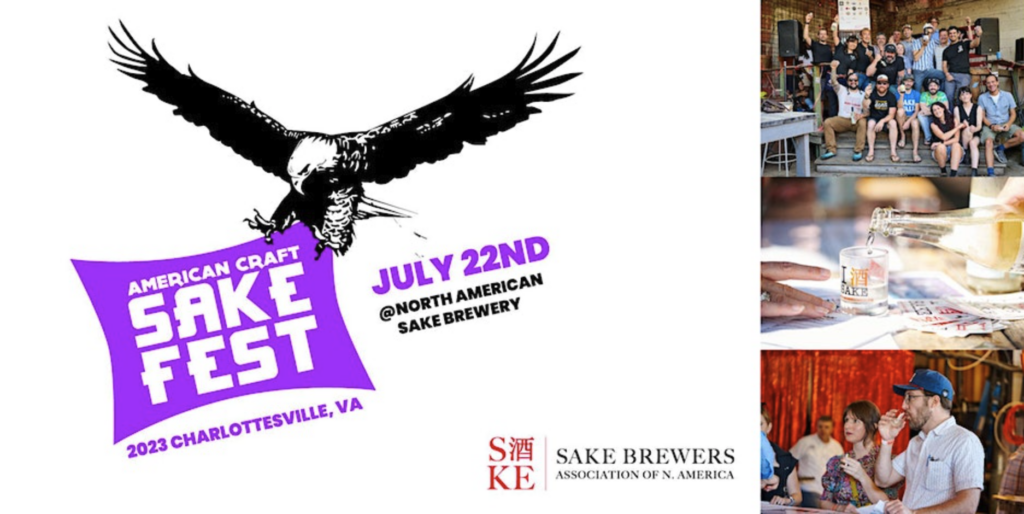Episode 150 Show Notes
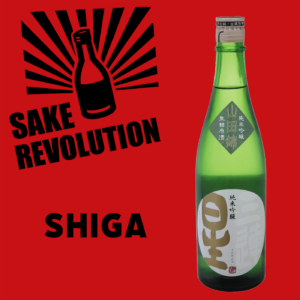 Episode 150. This week we continue our series on prefecture profiles with a special focus on those prefectures that are “landlocked” with no access to the sea or ocean. Despite no ocean view, Shiga is awash in water with 20% of it’s area covered by Lake Biwa, Japan’s largest lake! This water feeds a robust rice growing industry and there is a healthy sake industry in Shiga as well. When it comes to food, listen in as Timothy recounts a harrowing run-in with Shiga’s most famous, and definitely most funky fermented food that is best suited for – shall we say – extremely adventurous eaters. Today’s sake from Shiga’s Mifuku Shuzo is something new imported into the States and it’s always fun to try something new. Let’s explore Shiga sake together!
Episode 150. This week we continue our series on prefecture profiles with a special focus on those prefectures that are “landlocked” with no access to the sea or ocean. Despite no ocean view, Shiga is awash in water with 20% of it’s area covered by Lake Biwa, Japan’s largest lake! This water feeds a robust rice growing industry and there is a healthy sake industry in Shiga as well. When it comes to food, listen in as Timothy recounts a harrowing run-in with Shiga’s most famous, and definitely most funky fermented food that is best suited for – shall we say – extremely adventurous eaters. Today’s sake from Shiga’s Mifuku Shuzo is something new imported into the States and it’s always fun to try something new. Let’s explore Shiga sake together!
#sakerevolution
Skip to: 00:19 Hosts Welcome and Introduction
Welcome to the show from John and Timothy
Skip to: 02:59 Sake Spotlight: Shiga
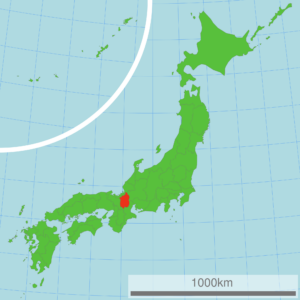
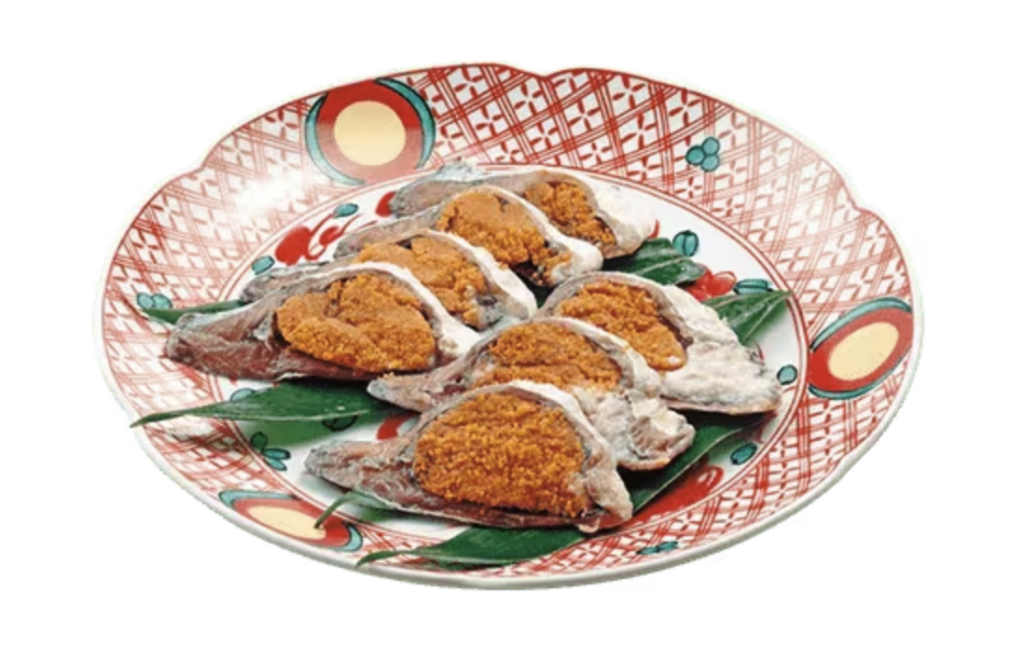
Photo: Kikkoman
Lake Biwa
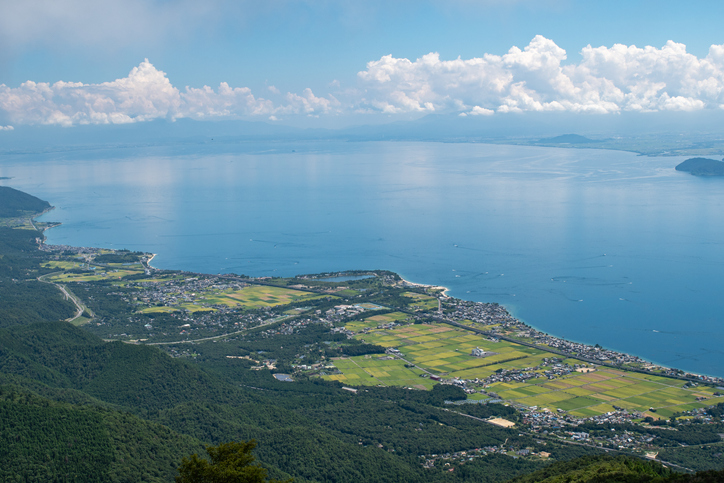
Skip to: 15:43 Sake Introduction and Tasting: Sanrensei Junmai Ginjo Namazume Genshu
Sanrensei Junmai Ginjo Namazume Genshu
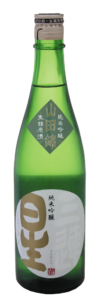
Alcohol: 16.5%
Classification: Junmai Ginjo Namazume Genshu
Prefecture: Shiga
SMV: +3.0
Acidity: 1.5
Brewery: Mifuku Shuzo
Seimaibuai: 55%
Brand: Sanrensei
Importer/Distributor: Wine of Japan (USA)
Rice Type: Yamdanishiki
Skip to: 24:46 American Craft Sake Festival
Get tickets for the American Craft Sake Festival!
https://www.eventbrite.com/e/american-craft-sake-festival-2023-tickets-593283746657
Skip to: 26:33 Show Closing
This is it! Join us next time for another episode of Sake Revolution!
Support us on Patreon
 Now there is a new way to support Sake Revolution. Join us on Patreon! Patreon is an online platform that allows you to support your favorite creators by subscribing to a monthly membership. At Sake Revolution, we’re offering two tiers, each with its own perk. If you enjoy our sake podcast, if you are able, please consider supporting this labor of sake love! See below to learn about our Patreon support levels.
Now there is a new way to support Sake Revolution. Join us on Patreon! Patreon is an online platform that allows you to support your favorite creators by subscribing to a monthly membership. At Sake Revolution, we’re offering two tiers, each with its own perk. If you enjoy our sake podcast, if you are able, please consider supporting this labor of sake love! See below to learn about our Patreon support levels.
-
Sake Enthusiast
Have you ever wanted to sip along with us as we taste our sakes on the podcast? Now you can! As a Sake Enthusiast patron, you’ll get the inside track and know in advance which sakes we’ll be featuring on the show. This allows you to get them on hand and sip along with us while you listen.
-
Sake Otaku
As a Sake Otaku supporter of the pod, you’ll get access to all the Sake Enthusiast intel along with access to a monthly live zoom Sake Happy Hour taking place the first Weds of every month at 9pm ET (6pm PT). Visit with us live on zoom! Come with all your questions and suggestions and enjoy a relaxed and fun Happy Hour with with us as we all sip sake together!
Episode 150 Transcript
[00:00:00] John Puma: Hello everybody and welcome to Sake Revolution. This is America’s very first sake podcast. Did You Know You’re listening to America’s Very First Sake podcast cuz you are, I’m your host John Puma, and I’m, from the Sake Notes also from the internet sake, discord and also, finally Reddit’s r slash sake community. But I can’t do this show alone. That’s why I always bring this gentleman with me.
[00:00:45] Timothy Sullivan: And I am your host, Timothy Sullivan. I’m Ma sake Samurai. I’m a sake educator, and I’m also the founder of the Urban Sake website. And every week John and I will be here tasting and chatting about all things sake and doing our best to make it fun and easy to understand.
[00:01:02] John Puma: Hello, Tim. How you doing
[00:01:03] Timothy Sullivan: I am doing good. How are you, John?
[00:01:06] John Puma: Excellent. I’m good. I’m good. It does occur to me, uh, having just said that, that if I had to just do the show by myself, it would be really boring. I wouldn’t have a lot of facts. I wouldn’t have a whole lot of education. There would be no corner. Uh, it would be a little, you know, I kind of just be like, Hmm, this, I’d sip something and be like, you know, this is tastes pretty good. You know?
[00:01:24] Timothy Sullivan: Yeah, and you would have no one to force you to put, uh, sake kasu masks on your face.
[00:01:30] John Puma: You know, continue your tradition of selling me on things when you’re not supposed to be selling me on them , and speaking of, continuing trends, today we’re gonna be moving along in our, our, I think I’m wondering, is this like a Micros series now? Cuz we’ve got our series on Japanese prefectures and now for the second week in a row. Little something special about the prefecture.
[00:01:55] Timothy Sullivan: This is, this is a series Subseries special.
[00:02:04] John Puma: Would you like to tell the good people at home what makes this one so special?
[00:02:07] Timothy Sullivan: Yes, well, we have a 47 part Prefecture series that we’ve been working on for three years, and, uh, it seems that we’ve unexpectedly, focused on landlocked prefectures. That means prefectures that have no access to the ocean. And, we are going to talk about another landlocked Prefecture today, and that is Shiga Prefecture.
[00:02:30] John Puma: Yes, yes, yes. Now, astute listeners will remember last week we talked about Gunma, which is landlocked, very mountainous. Shiga is landlocked and has. A giant lake in the middle of it. I could look like, when I was looking up information about Shiga, all of the photos showed water and like shorelines and also, and I was like, this doesn’t sh am I, do I looking up the right place. I’m very curious what’s going on here. And then I found that it’s actually, oh no, it totally is landlocked. It’s just, it’s somehow at the same time, landlocked and very, water inclusive,
[00:03:10] Timothy Sullivan: Yes,
[00:03:11] John Puma: the right word? Water inclusive.
[00:03:13] Timothy Sullivan: We’ll go with that for now.
[00:03:14] John Puma: Okay.
[00:03:15] Timothy Sullivan: Lake Biwa is the largest lake in Japan. It is smack dab in the middle of Shiga Prefecture, and it takes up one sixth of the entire Prefecture is this lake.
[00:03:30] John Puma: Now when you’re, if you’re doing like how big a prefecture is, do you count the the lake ma or is that like it’s subtracted from the land mass? Like how do you do this?
[00:03:38] Timothy Sullivan: I have no idea. But I do have a fun fact. The Lake Shore is 235 kilometers long.
[00:03:47] John Puma: That’s a lot.
[00:03:48] Timothy Sullivan: a lot.
[00:03:50] John Puma: I am, no, uh, I have no expert, but that sounds like an awful lot of lake.
[00:03:54] Timothy Sullivan: Yeah. But the, there are some mountains in Shiga Prefecture. We’ve got the Ibuki Mountains in the East and the Hiro Mountains in the west.
[00:04:04] John Puma: Mm-hmm.
[00:04:06] Timothy Sullivan: Also the Hebe Mountain. So there’s a whole bunch of mini mountain ranges in Shiga, but the, uh, elephant in the room when it comes to talking about Shiga geography is Lake Biwa, which is just huge. And that’s what everyone thinks of when they think of Shiga.
[00:04:22] John Puma: This, this giant puddle in the middle of the landmass.
[00:04:26] Timothy Sullivan: But the, the lake feeds a lot of water to the rice land of Shiga. So there’s, there’s sake rice that’s grown. It’s made possible by the huge water source that they have through Lake Biwa. Nihonbare and Tamae are two different sake rices that are well known from this region, and the water does not just supply Shiga, but also other prefectures benefit from water runoff from Lake Biwa as well.
[00:04:58] John Puma: Hmm. Okay. Uh, and now here’s the, the part of the show where I ask Tim, have you been to Shiga Prefecture before?
[00:05:08] Timothy Sullivan: I have
[00:05:10] John Puma: we’ve got a winner guys. We’ve got a live one. You’ve been to this prefecture. tell us a little bit about your visit.
[00:05:18] Timothy Sullivan: Well, I’ve been to Shiga a few times
[00:05:21] Timothy Sullivan: the one brewery that I’ve visited for sure is Tomita Brewery, which is imported into the US by Joto sake, and they make a really well known brand. Shichihonyari, and. It is a fantastic small family run brewery that is one of the oldest in Japan.
[00:05:43] John Puma: How old are we talking here?
[00:05:44] Timothy Sullivan: Tomita Brewery and Shiga was founded in 1540, us over 15 generations of family. It is as astounding
[00:05:57] John Puma: 1540. Wow.
[00:05:59] Timothy Sullivan: yes. So was that, was that William Shakespeare’s time? Maybe
[00:06:05] John Puma: I, so, all right, so in 1540, Henry VIII married Anne of Cleaves and uh, and there was a holy Roman emperor,
[00:06:15] Timothy Sullivan: Okay.
[00:06:16] John Puma: Wow. This is an old brewery.
[00:06:18] Timothy Sullivan: We’re just a pile of fun facts this episode, aren’t we?
[00:06:21] John Puma: Yeah. And they’re all fun. Every single one of them.
[00:06:24] Timothy Sullivan: Yeah. So Tomita Brewery is an amazing brewery. It is very historical, but the son of the last president has taken over and has done some amazing. Sake styles, they veer a little bit more towards rice forward, uh, earthy. But they have some very elegant, they have a very elegant Shizuku as well, and a Nigori that’s to die for. And I don’t say that often about nigori, but, fabulous. And , they’ve been exporting to the US even though they’re a small brewery with just a few workers there. They’ve been exporting for years, so they’re building up more and more of an export portfolio, so it’s getting increasingly easy to find their delicious sakes around. So please look for that.
[00:07:07] John Puma: Yeah, I’m a, I’m a fan myself of the Shichihonyari even though, uh, it is a little on the ricey-er side of things. And so I don’t often say that about ricey-er styled sake, but in their case, it’s, uh, it’s totally a winner.
[00:07:19] Timothy Sullivan: And I think for Shichihonyari, it’s a great example of like if Rice or maybe a a, a li a little whisper of earthiness is not your everyday go-to. They bring balance to it and they bring nuance to it. And I think it’s a great example of one of those sakes that can kind of cross styles and, you know, get you interested in different, different varieties of, of, uh, flavor profiles. So something to definitely look out for. So I had a coup, I know I’ve been to that brewery at least twice and uh, had a great time.
[00:07:50] John Puma: that’s interesting. I’ve never been to a brewery twice. That’s, uh, that sounds like a
[00:07:54] John Puma: good time. You get to kind of see how things have changed over the years.
[00:07:57] Timothy Sullivan: you have to be a pesky sake nerd like I am.
[00:08:02] John Puma: Tim, I, I never considered you to be pesky.
[00:08:04] Timothy Sullivan: Well, maybe, maybe the brewers of Shiga do Now, do you wanna take a, do you wanna take a guess how, how many sake breweries we have in Shiga?
[00:08:15] John Puma: hmm. Well, we’re losing an awful lot of that landmass
[00:08:19] Timothy Sullivan: Yeah, that’s true.
[00:08:20] John Puma: to the water and you can’t put a brewery in the water as far as I’m aware. So, on our scale of 90 to one that we established last time, uh, or 90 being the most breweries, or that most breweries, we know that it’s not 90 and we know it’s not one. So, and I’m listening to, I’m gonna say something like 15 or 20.
[00:08:41] Timothy Sullivan: Well, how about double that? We got about 32, 32 ish breweries. Again, give or take a, a few brewing licenses in there. Uh, but my count, my, my count is 32 breweries in Shiga, which is more than you’d think for a relatively small Prefecture.
[00:09:01] John Puma: yeah. And, and again, like they, they’re, they don’t get to use all that land. That’s very interesting. I. Very cool, very cool. I, I would like to visit shiga one day, and I, and I promise you that the the point of our, going back to our prefecture shows is not simply for me to shop around and find where I’m gonna visit next time I’m in Japan, but you know, I may use some of this information. now, now, Tim, you said you’ve been over the Shiga a couple of times. What, what’d you learn? What, what, what goes on over there? What’d you do apart from visiting Shichihonyari. Twice.
[00:09:29] Timothy Sullivan: Well, I did visit Lake Biwa and was driven around the lake, so we had some lakeside viewing. I saw a bear in real life, so there was a, this is in the rural countryside, so there was like a bear crossing the street, which you sometimes see in the mountainous areas, and. I have to say in Shiga, I loved it. It was beautiful. I had many good meals there, but I had a borderline traumatic experience too. It was the
[00:10:01] John Puma: Wait, wait, wait. You had a borderline traumatic experience and it wasn’t meeting the bear. The bear wasn’t the borderline traumatic experience for me. seeing the bear is the traumatic experience.
[00:10:13] Timothy Sullivan: no, no. The bear was, was, uh, Very
[00:10:17] John Puma: Friendly, the friendly pair.
[00:10:19] Timothy Sullivan: No, it just kind of ran across the road and disappeared into the forest. So it was, that was no big deal. But the, um, the more traumatic experience was culinary in nature.
[00:10:30] John Puma: Ooh,
[00:10:31] Timothy Sullivan: Now you, you hear about foreigners going to Japan and having challenging food experiences. You can, you can identify with that, right,
[00:10:38] John Puma: I don’t know what you’re talking about at all, Tim.
[00:10:42] Timothy Sullivan: Well, I had, let’s just say this, I had the most challenging Japanese food experience of my entire life in Shiga Prefecture, and it, it’s a food they’re most famous for.
[00:10:56] John Puma: Uh huh. Alright.
[00:10:58] John Puma: All right. I’m
[00:10:58] Timothy Sullivan: you may be served this, you’re gonna bite. I did not bite. I
[00:11:01] John Puma: no, no, no. It’s not what I meant when I said I’m gonna bite. No, no, no. I’m gonna bite. I need to know what this meal was.
[00:11:09] Timothy Sullivan: Okay, well it comes from Lake Biwa. We’ll start with that.
[00:11:13] John Puma: Okay, it is sea life of some kind.
[00:11:16] Timothy Sullivan: it came from Lake Biwa.
[00:11:18] John Puma: It came from Lake Biwa.
[00:11:20] Timothy Sullivan: so there is a type of fish called a Funa or. A Crucian carp. So it’s a, it’s a lake fish and there is a fermented version of this fish called Funazushi. Funazushi
[00:11:38] John Puma: Funazushi, and you’re saying that it’s a fermented fish, A
[00:11:42] Timothy Sullivan: Yes. It is a carp that comes from Lake Biwa and they stuff it with rice. Then they ferment it for months
[00:11:55] John Puma: Mm.
[00:11:56] Timothy Sullivan: and I don’t know exactly how they do it, but when it comes out, it is sl. It’s like the whole fish is then sliced and I’m gonna put a picture in the show notes and It has a reputation that Japanese people can sometimes even not handle this food. It smells like old funky fish. And this was a preservation method before refrigeration existed. So it is technically edible and it will not technically kill you, but it
[00:12:33] John Puma: I don’t know if I like that kind of technicality in my cuisine.
[00:12:38] Timothy Sullivan: But it had this old, fishy, fermented smell that I, I did try it, but I had to tell the restaurant people that I was so sorry. I could not
[00:12:52] John Puma: Mm-hmm.
[00:12:53] Timothy Sullivan: it. It was just beyond, it was beyond my ability to eat it.
[00:12:59] John Puma: All right. Okay. And lemme tell you, lemme tell you, when you said, fermented fish, I kind of started down the road of, I can see where the trauma may lie.
[00:13:09] Timothy Sullivan: if you Google Funazushi, There are a lot of articles, kind of sensationalizing how funky it is.
[00:13:18] John Puma: Oh,
[00:13:20] Timothy Sullivan: some people call it the funkiest sushi you’ve ever eaten. hardly edible fish, evokes a aromas of tangy blue cheese feet and a whiff of ammonia. And people say it just plain smells bad.
[00:13:32] John Puma: it. I don’t know if you can smell a photo, but I’m looking at this now and I think I get it. Um, I think I might have some trouble, uh, if I tried to have this.
[00:13:46] Timothy Sullivan: It’s pickled, and then they compress steamed rice around it to seal out the air and basically let it sit for several months, and this fermentation happens that that preserves it and gives it this funky preserved flavor. But gosh, it was just super challenging.
[00:14:09] John Puma: Yeah, it sounds and looks. It sounds and looks like it. I believe you.
[00:14:14] Timothy Sullivan: but I do wanna emphasize that Shiga is wonderful and that you do not, you’re not obligated to eat this if you go there.
[00:14:23] John Puma: Okay. That’s, that is good to know.
[00:14:26] Timothy Sullivan: have you, have you had any experiences like that, John, where you’ve been presented with something that was just a no go in Japan, that
[00:14:32] John Puma: Oh yeah. I mean, you know, let’s not forget that I am. The opposite of Culinarily. Adventurous, uh, you know, I’m very, easily intimidated by foods I’ve not seen before. And so, yeah, a lot of times where I’ve been presented with, with the food that I considered to be challenging, uh, that I’ve been a little concerned. you wanna be polite and do the, do the right thing, and you, you. Push forward, but it’s hard sometimes it’s really difficult, I totally get it.
[00:15:01] Timothy Sullivan: Okay, well, my advice to you is do not eat Funazushi and Shiga.
[00:15:10] John Puma: I think I already got that advice when he told me about it.
[00:15:13] Timothy Sullivan: Well now, now I’m a hundred percent sure it’s not for you.
[00:15:16] John Puma: it. Okay. Yeah, that sounds, sounds like a, sounds like a plan.
[00:15:19] Timothy Sullivan: So, but John. Does this mean we’re tasting Shichihonyari sake? Cuz we, uh, talked about my visit there.
[00:15:26] John Puma: no, that would be too easy.
[00:15:30] Timothy Sullivan: but we, we do want everyone to run out and get Shichihonyari sake and drink it as much as you possibly can. But we’re actually gonna hop to a different brewery in Shiga and this is a sake that I have not had before.
[00:15:43] John Puma: Yeah. This is fun. I don’t get to do this with you very often, but um, but the sake that we’re gonna be. Tasting today is, is, is kind of new to the area, kind of new to New York. Uh, I’m not sure if it’s new to America, but it might be. And I had it by chance one night at dinner. It was the only sake on the menu that I didn’t recognize, and it was their special that day. So I ordered a glass and I was very happy that I did. , and then I went out and I, I was able to find a bottle and I was like, Tim, let’s, let’s do something with this.
[00:16:16] Timothy Sullivan: All right. Well, I will tell our listeners that this is from Mifuku Shuzo, which is a baby compared to Tomita Shuzo. Uh, Mifuku Shuzo was founded in 1917, so a little bit over a hundred years old and a spring chicken compared to Tomita. So do you wanna let us know which sake from Mifuku we are tasting and uh, give us some of the stats?
[00:16:45] John Puma: Sure. So this is their, uh, Sanrensei Junmai Ginjo. And it’s a Namzume Genshu. So that’s a fun one right there. , Tim, you wanna refresh everybody’s memory about what Namazume is exactly.
[00:17:00] Timothy Sullivan: Yeah, Namazume in the shortest possible explanation means once pasteurized, so this is usually pasteurized before a storage time at the brewery. So, And then not pasteurized a second time right when you’re bottling. So it’s a middle step between a truly unpasteurized sake or a more traditionally twice pasteurized sake. So just, just remember once pasteurized.
[00:17:27] John Puma: and it’s
[00:17:27] Timothy Sullivan: a
[00:17:28] John Puma: genshu uh, which means that it is, not water diluted in any way. It doesn’t necessarily mean it’s extra boozy, it just means that it has not had additional, water added. Uh, that we have an episode where I talk exclusively about Genshu. And sip a good one too, if I’m not mistaken. the rice that is on display here is, uh, yamadanishiki, the King of Sake rice. And, uh, that Yamahai has been milled down to 55% of its original size. Our sake meter value is a 1.5. That’s that meter of dryness to sweetness. , and uh, the alcohol percentage is 16 and a half.
[00:18:04] John Puma: So just a, just a touch above average.
[00:18:06] Timothy Sullivan: It’s a little lower than what you’d expect for a Genshu, as you mentioned. Yeah. Now the brand name. Is Sanrensei, which means three stars. And my understanding from my very quick research into this brewery is that they’ve had three generations since their founding. So it’s a nod to the three generations that have come in their brewery.
[00:18:34] John Puma: Nice. I like that. yeah. I, when, when you originally said, uh, three stars, I was like, oh, they’re selling themselves a little short. Maybe it’s really good sake. Maybe
[00:18:45] Timothy Sullivan: This isn’t, this isn’t a Yelp review, John Puma.
[00:18:50] John Puma: Uh, so yeah, let’s, uh, let’s get some of this in the glass.
[00:18:53] Timothy Sullivan: All right. I’m ready to give it a smell.
[00:19:02] John Puma: So let me tell you, the first thing I noticed when I was poured at the sake originally was the aroma.
[00:19:13] Timothy Sullivan: Hmm.
[00:19:15] John Puma: And it’s that big fruity bouquet that I enjoy so much, and I was like, wow. If you wanted to catch. Me out in the wild, you put this, you put a glass of this in the bear trap and I’m gonna come, come strolling along and I will not be able to resist the aroma.
[00:19:33] Timothy Sullivan: So we should put the Sanrensei, not the Funazushi in the bear trap to get to capture. Okay, got it. got it, got it.
[00:19:39] John Puma: I don’t think the Funa, I don’t think the Funazushi is gonna get me.
[00:19:43] Timothy Sullivan: So, um, this is a fruity aroma, but I’m getting some kind of like melon rind aroma. you know, it, there’s a little bit of. Hint of rice to me as well, so it’s not like the full-blown gorgeous fruit salad. There’s a little bit of fruit, but I get some melon rind and just this whisper of something rice earthy in there for me.
[00:20:09] John Puma: Hmm. There is a earthiness, but the earthiness and the fruit in my, my animal brain translates a little bit into those stone fruits. A touch of that, but with your lighter fruits in there as well. It’s a really, it’s a, it’s a kind of like a, a little bit of that, the traditional fruit salad, but I, the tr the fruit salad that’s been. Out a little bit long and wait, wait. You know how it gets a little syrupy at the, you know, at the bottom and it gets a little more, a little more tart.
[00:20:39] Timothy Sullivan: yes.
[00:20:40] John Puma: Kind of like that, you know, got a little bit of that.
[00:20:42] Timothy Sullivan: You and I have talked about the canned fruit syrup before. Right.
[00:20:49] John Puma: that too.
[00:20:51] Timothy Sullivan: As you say to quote John Puma, we’re going back to the the well,
[00:20:54] John Puma: Yeah. Yeah. Yeah. , by the end of this show, there’s gonna be comments about , a gentle wafting from the other room.
[00:21:01] Timothy Sullivan: all right, well, let’s give it a taste.
[00:21:03] John Puma: All right?
[00:21:03] Timothy Sullivan: So it’s fruity, it’s rich. It does have a little bit of that syrupy, little bit of sweetness to it, but the finish is, is dry and you get just the hint of that higher alcohol, like the 16.5%. Uh um, I feel that more on the finish.
[00:21:24] John Puma: Yeah, and I think that, I think kinda like when we were talking about the oze recently, that bit of, that that alcohol there helps to temper the fruit a bit. And I think that much , much like in that situation, this one, if it didn’t have that, if it didn’t have the alcohol to, To stop it in its tracks a little bit. It might be a little too much.
[00:21:43] Timothy Sullivan: Right. and I think you can feel what they’re trying to do with making this a namazume, like it’s once pasteurized. So that kind of pulls the reigns in a little bit from being too overblown or we mentioned briefly about their sake, rice growing abilities Nipponbare, Tamae. These rices are known to be a little more rice forward in flavor, and I think that Shiga has that proud rice character in their sakes
[00:22:14] John Puma: Hmm. So this turned out nice. This is a good, new sake on the block. You know, it’s not doing anything crazy. It’s not doing anything wild, but , it’s nice and solid. There is that, that once pasteurized, uh, kind of a play a little bit on your tongue, which I like as well.
[00:22:28] Timothy Sullivan: Mm-hmm.
[00:22:29] John Puma: it’s just solid all around Shiga, making good sake.
[00:22:32] Timothy Sullivan: Yeah. So this, this brewery is in. Koka City, K O K A, which is in the southern part of Shiga. It’s a bit away from Lake Biwa. I think Tomia Shuzo is just a short drive from Lake Biwa and
[00:22:51] John Puma: far from Lake Biwa as one can get in Shiga.
[00:22:54] Timothy Sullivan: yes. , it’s a really interesting. To try a sake that’s newly imported. And, something a little different with a yeast, we don’t know. It’s like opening up, a Christmas gift
[00:23:09] John Puma: Yeah, it’s a brewery we really didn’t know. a prefecture, we don’t have a lot of sake from a yeast we don’t know, but a flavor that’s somewhat familiar.
[00:23:18] Timothy Sullivan: Yeah.
[00:23:18] John Puma: They’re, they’re doing that thing. They’re, they’re just doing it really nicely.
[00:23:21] Timothy Sullivan: So John, uh, what, besides the horrifying tale I told you about, fermented fish, uh uh, what. Do, do you think you’re still gonna go to Shiga now after, after that story?
[00:23:35] John Puma: I might, I may avoid the, you said this is the most famous local cuisine
[00:23:39] Timothy Sullivan: It’s the most famous,
[00:23:41] John Puma: I may avoid the most famous local cuisine.
[00:23:43] Timothy Sullivan: I think it’s pretty expensive and rare. So you have, you have to go to like a special master who produces it. So it’s not something you’re gonna see at every train station gift shop, so you really have to seek it out. So I think you’re safe.
[00:23:58] John Puma: Thank you very much.
[00:23:59] Timothy Sullivan: Okay. All right. Well, I’m excited to go back to Shiga and I still have not made good on my. New Year’s Revolution resolution, which is to get back to Japan, but hopefully before December I’m gonna make it back over there. There’s something in the works I can’t reveal too much, but, uh, we’re gonna be hopefully doing some reporting from. Japan from yours truly. Uh, but until then, I think that wraps it up for another landlocked Prefecture sake episode.
[00:24:34] John Puma: I think so.
[00:24:35] Timothy Sullivan: Our riveting new series.
[00:24:39] John Puma: How many more landlock sake episodes do we have? We’ll find out next week.
[00:24:44] Timothy Sullivan: Tune in next week.
[00:24:45] John Puma: Yeah.
[00:24:46] Timothy Sullivan: Now, before we wind up, I do want to. Announced to our listeners that we are going to be taking Sake Revolution on the road, and we have an exciting event to announce to everybody who, John and I will be attending an podcasting From The Craft Sake Festival in Charlottesville, Virginia, which is happening on Saturday, July 22nd, 2023, it is the foremost gathering of US sake brewers in the country, and it is the best place to try the most amazing domestic US made sakes.
[00:25:30] John Puma: Yeah, I’m really, really excited for this because number one, we haven’t done a show on location in a really long time. I think the last time we did was at your apartment, which is, shouldn’t really be considered on location, Tim. Well, you know, it wasn’t, uh, I, I left the house so it was on location for me. I would say decibel. Then Decibel was our last on location. But
[00:25:51] Timothy Sullivan: alright. This is on the road
[00:25:53] John Puma: and wild. Yeah. Yeah. And it’s gonna be a good time. We’re gonna have, a little booth. You can come by if you’re there. , tell us a couple of things about the sakes you’ve been tasting. Maybe we’ll record it for the show. You never know what might happen. We’re in, I think while we’re there, we’re gonna try to, reign in a couple of, local sake brewers as well. So that’s exciting.
[00:26:13] Timothy Sullivan: if you would like to get tickets to the Craft Sake Festival, please visit SakeAssociation.org and you can buy your tickets online from the Sake Brewers Association of North America, and we will have all those links and information in our show notes, so be sure to check it out.
[00:26:32] John Puma: Sounds exciting.
[00:26:33] Timothy Sullivan: Yes. So in addition to that, we want to thank you for listening and enjoying Sake Revolution. If you would like to support our podcast, we do have a Patreon and we love our patrons. And thank them so much for supporting us week in and week out. If you’d like to learn more, visit patreon.com/Sakerevolution.
[00:26:54] John Puma: And. Did you know that we also have at our website, SakeRevolution.com swag, we have a little swag shop. You can buy shirts and you can buy stickers and most importantly, new shirts. So we have a brand new shirt on the site. It is June, so it is Pride Month, and we’ve got our new Pride T-shirt and the profits from those shirts will be going to the Trevor Project, for at risk youth. and that we’re excited to be, uh, helping out. I think that’s kind of fun. I think it’s a nice,
[00:27:26] Timothy Sullivan: It’s a good cause and we’ve been promising new merch for months.
[00:27:31] John Puma: Yeah. Finally, we’re finally doing something about it.
[00:27:36] John Puma: Yes. on that note, Please grab a glass. Remember to keep drinking sake and Kanpai.
